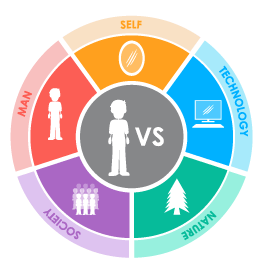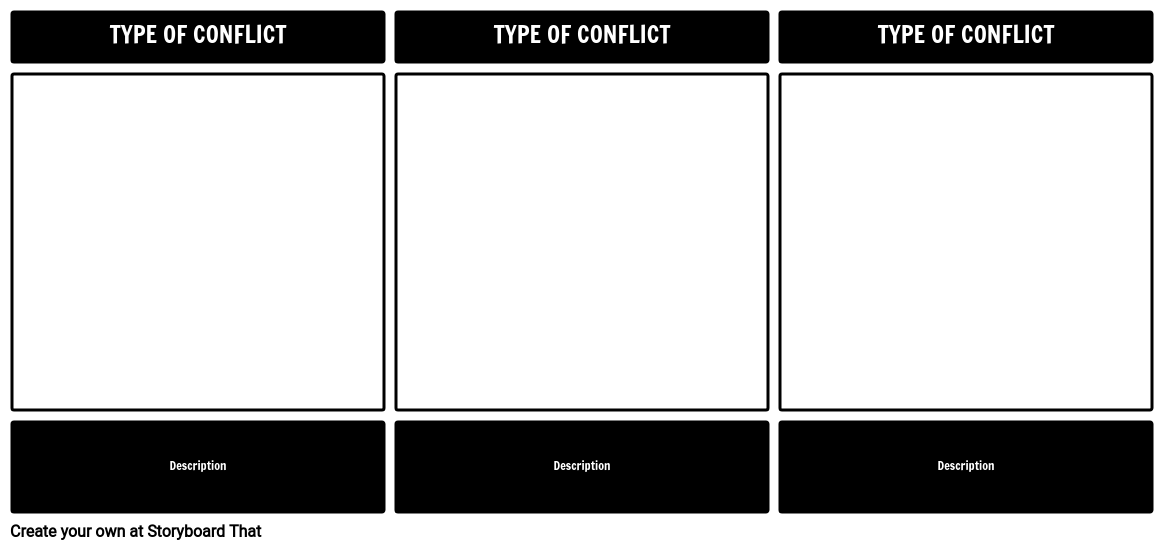Lesson Plan Overview
Storyboarding is an excellent way to focus on types of literary conflicts.
Having students create storyboards that show the cause and effect of different types of conflicts strengthens analytical thinking about literary concepts. Have your students choose an example of each literary conflict and depict them using the Storyboard Creator. In the storyboard, an example of each conflict should be visually represented, along with an explanation of the scene, and how it fits the particular category of conflict.
Examples of Literary Conflict in Julie of the Wolves
CHARACTER vs. MAN
Miyax’s conflict with Daniel is the spark that sets the story in motion. When Daniel threatens her, Miyax feels terrified and unsafe. This leads her to run away, ultimately getting lost in the wilderness.
CHARACTER vs. NATURE
Miyax is in conflict with nature when she finds herself starving in the tundra. After the lemming population dies off, the larger game leaves the area, and Miyax cannot find anything to eat. Her conflict with nature puts her in danger of death.
CHARACTER vs. TECHNOLOGY
Guns create a conflict for Miyax when hunters come to the tundra. They shoot at her pack of wolves, killing Amaroq and wounding Kapu. The guns bring fear and sorrow into Miyax’s happy life on the tundra.
CHARACTER vs. SOCIETY
As an Eskimo, Miyax struggles to find a place in the modern world. She loves living off the land and is uncomfortable with returning to civilization. All the cities, schools, neat little houses, and modern technology make her uncomfortable. By the end of the book, “civilization [becomes a] monster” to Miyax.
Template and Class Instructions
(These instructions are completely customizable. After clicking "Copy Activity", update the instructions on the Edit Tab of the assignment.)
Student Instructions
Create a storyboard that shows at least three forms of literary conflict in Julie of the Wolves.
- Identify conflicts in Julie of the Wolves.
- Categorize each conflict as Character vs. Character, Character vs. Self, Character vs. Society, Character vs. Nature, or Character vs. Technology.
- Illustrate conflicts in the cells, using characters from the story.
- Write a short description of the conflict below the cell.
Lesson Plan Reference
Student Rubric
(You can also create your own on Quick Rubric.)
| Proficient | Emerging | Beginning | |
|---|---|---|---|
| Conflict Identification | Student identifies conflicts as directed and labels them accurately in their correct categories. | Student misidentifies one conflict or includes it in an incorrect category. | Student misidentifies two or more conflicts or includes them in incorrect categories. |
| Conflict Explanation | The storyboard text describes the specific example depicted, not just a general problem. The text clearly explains how the example reflects its particular type of conflict. | The storyboard text describes the specific example depicted, but may lack clarity. Text may fail to fully explain how the example reflects its particular type of conflict. | Storyboard is missing text or contains only partial and/or inaccurate information. |
| Storyboard Image and Effort | Student clearly shows effort to convey the setting, characters and specific scene of the book. The scene is clearly identifiable based on the graphic depiction. | Student attempts to convey the setting, characters, and specific scene through use of graphics, but the depiction may be confusing, disordered, or lack some detail. | Student does not clearly convey the setting, characters, and scene. |
| Spelling and Grammar | Student uses exemplary spelling and grammar. There are no errors. | Student makes one or two minor errors in spelling and grammar. | Student makes multiple errors in spelling and grammar. |
Lesson Plan Overview
Storyboarding is an excellent way to focus on types of literary conflicts.
Having students create storyboards that show the cause and effect of different types of conflicts strengthens analytical thinking about literary concepts. Have your students choose an example of each literary conflict and depict them using the Storyboard Creator. In the storyboard, an example of each conflict should be visually represented, along with an explanation of the scene, and how it fits the particular category of conflict.
Examples of Literary Conflict in Julie of the Wolves
CHARACTER vs. MAN
Miyax’s conflict with Daniel is the spark that sets the story in motion. When Daniel threatens her, Miyax feels terrified and unsafe. This leads her to run away, ultimately getting lost in the wilderness.
CHARACTER vs. NATURE
Miyax is in conflict with nature when she finds herself starving in the tundra. After the lemming population dies off, the larger game leaves the area, and Miyax cannot find anything to eat. Her conflict with nature puts her in danger of death.
CHARACTER vs. TECHNOLOGY
Guns create a conflict for Miyax when hunters come to the tundra. They shoot at her pack of wolves, killing Amaroq and wounding Kapu. The guns bring fear and sorrow into Miyax’s happy life on the tundra.
CHARACTER vs. SOCIETY
As an Eskimo, Miyax struggles to find a place in the modern world. She loves living off the land and is uncomfortable with returning to civilization. All the cities, schools, neat little houses, and modern technology make her uncomfortable. By the end of the book, “civilization [becomes a] monster” to Miyax.
Template and Class Instructions
(These instructions are completely customizable. After clicking "Copy Activity", update the instructions on the Edit Tab of the assignment.)
Student Instructions
Create a storyboard that shows at least three forms of literary conflict in Julie of the Wolves.
- Identify conflicts in Julie of the Wolves.
- Categorize each conflict as Character vs. Character, Character vs. Self, Character vs. Society, Character vs. Nature, or Character vs. Technology.
- Illustrate conflicts in the cells, using characters from the story.
- Write a short description of the conflict below the cell.
Lesson Plan Reference
Student Rubric
(You can also create your own on Quick Rubric.)
| Proficient | Emerging | Beginning | |
|---|---|---|---|
| Conflict Identification | Student identifies conflicts as directed and labels them accurately in their correct categories. | Student misidentifies one conflict or includes it in an incorrect category. | Student misidentifies two or more conflicts or includes them in incorrect categories. |
| Conflict Explanation | The storyboard text describes the specific example depicted, not just a general problem. The text clearly explains how the example reflects its particular type of conflict. | The storyboard text describes the specific example depicted, but may lack clarity. Text may fail to fully explain how the example reflects its particular type of conflict. | Storyboard is missing text or contains only partial and/or inaccurate information. |
| Storyboard Image and Effort | Student clearly shows effort to convey the setting, characters and specific scene of the book. The scene is clearly identifiable based on the graphic depiction. | Student attempts to convey the setting, characters, and specific scene through use of graphics, but the depiction may be confusing, disordered, or lack some detail. | Student does not clearly convey the setting, characters, and scene. |
| Spelling and Grammar | Student uses exemplary spelling and grammar. There are no errors. | Student makes one or two minor errors in spelling and grammar. | Student makes multiple errors in spelling and grammar. |
How Tos about Julie of the Wolves Literary Conflict
Use group discussions to deepen understanding of literary conflict
Encourage students to share their interpretations of conflict scenes in small groups. Group discussions allow students to hear diverse perspectives and clarify their own thinking about the story's conflicts.
Assign each group a different conflict type to analyze
Have each group focus on one type of conflict (e.g., Character vs. Nature). Students can identify examples, discuss their importance, and report back to the class for a comprehensive understanding.
Guide students to connect story conflicts to real-life scenarios
Ask students to think of situations in their own lives or current events that resemble conflicts from the book. This helps students see the relevance of literary conflicts and builds empathy.
Facilitate a class discussion using open-ended questions
Pose questions like, "How do you think Miyax felt during her conflict with nature?" Open-ended questions spark deeper conversation and critical thinking about character motivations and outcomes.
Frequently Asked Questions about Julie of the Wolves Literary Conflict
What are the main types of literary conflict in Julie of the Wolves?
Julie of the Wolves features several key types of literary conflict, including Character vs. Character (Miyax vs. Daniel), Character vs. Nature (Miyax's struggle to survive in the tundra), Character vs. Technology (impact of guns on the wolf pack), and Character vs. Society (Miyax's discomfort with modern civilization). Each conflict shapes Miyax's journey and growth.
How can students storyboard literary conflicts from Julie of the Wolves?
Students can use a Storyboard Creator to visually depict different conflicts from the novel. Each cell should show a specific scene, illustrate the conflict type (like Character vs. Nature), and include a brief description explaining its significance in the story.
What is an example of Character vs. Nature conflict in Julie of the Wolves?
An example of Character vs. Nature is when Miyax faces starvation in the tundra after the lemming population dies off. She must battle the harsh environment to survive, highlighting her resilience and resourcefulness.
Why is exploring literary conflict important for middle schoolers reading Julie of the Wolves?
Exploring literary conflict helps middle schoolers develop critical thinking by analyzing character motivations and story outcomes. Understanding conflict deepens their comprehension and engagement with the novel’s themes.
What steps should teachers follow to help students identify conflicts in Julie of the Wolves?
Teachers should guide students to: 1) Read key scenes, 2) Identify the type of conflict (e.g., Character vs. Society), 3) Illustrate the scene, and 4) Write a short explanation connecting the conflict to the story’s message.
More Storyboard That Activities
Julie of the Wolves
Testimonials

“By using the product, they were so excited and they learned so much...”–K-5 Librarian and Instructinal Technology Teacher

“I'm doing a Napoleon timeline and I'm having [students] determine whether or not Napoleon was a good guy or a bad guy or somewhere in between.”–History and Special Ed Teacher

“Students get to be creative with Storyboard That and there's so many visuals for them to pick from... It makes it really accessible for all students in the class.”–Third Grade Teacher
© 2026 - Clever Prototypes, LLC - All rights reserved.
StoryboardThat is a trademark of Clever Prototypes, LLC, and Registered in U.S. Patent and Trademark Office








